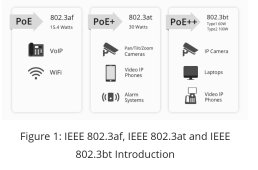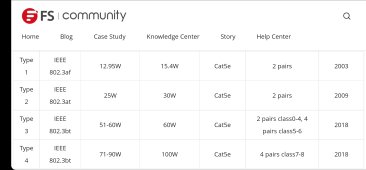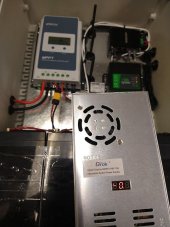timselectric
If I can do it, you can do it.
- Joined
- Feb 5, 2022
- Messages
- 18,955
That's too much available input power, for a MPPT.
Use a cheap PWM.
Use a cheap PWM.
That's too much available input power, for a MPPT.
Use a cheap PWM.
Just going on what I have read in the past.I believe you have it backwards.
PWM can't effectively regulate current. They work by shorting the source to the battery, i.e., shorting a 24V battery to a 12V battery.
POEs put out. .3 to .6 amps per pair max at 50ish volts no where near even 1 amp. so if you connected 2 of the cat cable to the input of your mppt you get 30 watts so of course it overloaded.A little back story. The company I work for has a IOT system that runs on solar. Basically a 20a EPEver MPPT, 200w panel, and 100ah LiFePO4
I wanted the guys in the shop to be able to maintain/charge these units before they go out to a new site. I experimented hooking up POE power supplies that have 54vdc out to the MPPT. I went through several, some were rated 2.5a, and some 5a.
They all had the same problem, it would initially work but the MPPT would pull it down, then PSU shuts off, then comes back in a cycle. Also managed to totally kill a few of the PSUs


The thing you have to watch out for is to not have a power supply that would exceed the Victron MPPT input current spec which would normally be the Isc of the PV panel.
Also, the power supply will have to be 5V over battery voltage for the MPPT to start.
And the question that remains is why does the max input current spec exist? Can the controller try to sink a short circuit current from the PV. If it does, are these fuses being put on to protect going to be blowing constantly.Victron publishes max PV input current. The aforementioned fuse on the PV connection would suffice. A 24V battery should always be 5V or more above the 12V.
And the question that remains is why does the max input current spec exist? Can the controller try to sink a short circuit current from the PV. If it does, are these fuses being put on to protect going to be blowing constantly.
POEs put out. .3 to .6 amps per pair max at 50ish volts no where near even 1 amp. so if you connected 2 of the cat cable to the input of your mppt you get 30 watts so of course it overloaded.
There is also info about Victron will short its PV input to protect itself: Notes I am not sure other SCC manufacturers use this method (Crowbar the PV input) as Victron.
page 60:
A higher short circuit current may damage the solar charger in case of reverse polarity connection of the PV array.
You think that is really how they came up with that spec? In case they were hooked up in reverse? There goes your need to have those fuses.
page 60:
A higher short circuit current may damage the solar charger in case of reverse polarity connection of the PV array.
never seen a POE with an external brick. all our stuff is integrated into the switch or a power inserter for a single line...I didn't use POE itself nor did I use cat5 cable. I used the 54vdc power bricks that we use to power POE switches. Some of these power bricks I used do 54vdc at 5amps
like this: https://www.amazon.com/COOLM-100-240V-Switching-Transformer-Interface/dp/B07G21P3KD
never seen a POE with an external brick. all our stuff is integrated into the switch or a power inserter for a single line...
learned new stuff all the time
that 20a mttp at 13.8v is 276w or 6.1 amps at 45v so it would still over load a 5 amp brick

Now try it with a fully charged 24 volt lthium battery on the input please.


